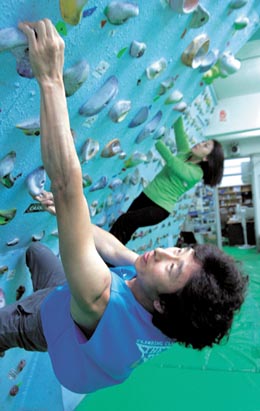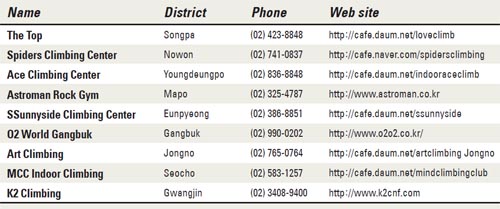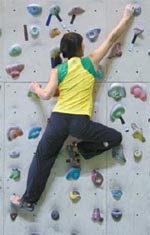A sport that has people climbing the walls

Indoor climbing coach, Yoo Seok-jae, scales the climbing wall at The Top in Songpa District, southeastern Seoul. [JoongAng Ilbo]
Although many people consider climbing dangerous, it is a rather safe sport. If you’ve never climbed before, doing it in a gym can be less intimidating and you’ll be happy to know that it gives you a full-body workout that tones the arms and legs without adding bulk.
Expats will find there are plenty of instructors in Seoul who speak enough English to demonstrate basic postures.
“We have couple of expats learning to climb at the center, and since it’s a workout you do yourself, it doesn’t require too much discussion,” said Jung Ji-hyun, of Ace Climbing Center in Yeongdeungpo District.
Finding your center
There are indoor climbing centers all around the city, including ones in Songpa, southeastern Seoul, Eunpyung, northwestern Seoul, Seocho, southern Seoul, Jongno, central Seoul, and Nowon, northeastern Seoul.
These centers offer sleek facilities with walls that are about 2 meters (6 feet 6 inches) high at most, about as tall as your home or office space.
For beginners, it is much more important to learn how to move steadily from one hold to the next on a lower wall before moving on to higher ones. For more experienced climbers, each wall is set at a different angle, providing an added challenge.
Beginners start on walls that are inclined about 5-15 degrees from the main wall. More advanced climbers can work on walls that are inclined at angles of about 45 degrees or work out on the ceiling.
All the holds on the wall are different shapes and sizes. At The Top indoor climbing center in Songpa District, it’s almost impossible to find two holds that are alike. The holds at this particular center are designed to appeal to a wide range of climbers. Some are a bit whimsical, such as the ones shaped like teddy bears that seem to have been designed with young climbers in mind.
Necessary equipment
One of the good things about indoor climbing is that you don’t need much equipment besides a good pair of climbing shoes. The right size shoe will have a tight fit that gives your toes a slight curve, so it’s important to try the shoes on before investing in a pair.
Climbing tape is also essential, since your fingers will develop blisters after three or four sessions. To prevent blisters, tape your fingers before starting your climb. Climbing tape is made so that it doesn’t slide when the climber is working and the sticky side is designed not to leave residue on the fingers.
Warm up before getting on the wall
Since climbing is a whole body exercise, you will use muscles that you rarely use in everyday life, including those in your fingertips. If you don’t warm up, you could injure yourself and you are not likely to perform as well when you’re on the wall. So before you start, it is important to warm up the body with light exercises that will get your blood moving.
“A warm up is the fastest and easiest way to prevent yourself from getting hurt during the activity,” said sports climbing coach Kang Se-won of The Top in Songpa District.
Start with some light aerobic activity. Take a brisk walk around the gym, jog in place or get down in the trenches and do an army crawl. Next, move on to stretching. The point here will be to loosen the joints, rather than stretching the muscle to the max. Rotate your wrists, ankles, neck, shoulders and hips both clockwise and counterclockwise and repeat 8-10 times on both sides.
Stretch your hands by holding your arm out in front of you, palm up, and then gently pull the fingers back toward the body. Then, reach both arms out behind you and clasp your hands in the middle of your back, then bend forward, pushing your arms upward.
Getting a grip
If you’ve never climbed before, the first thing you’ll do is practice the basic posture. Standing in front of the wall, grab two holds above your head that are parted a little wider than your shoulders. Keeping your arms straight and your hips down (imagine sitting in an extremely low chair), step onto the wall using holds that are in line with your hands. This is the position you will return to each time you complete a move up the wall.
Once you are comfortable with the basic posture, you will start practicing routines. Most climbing centers have color coded climbing routes that are organized according to difficulty and some centers also have numbered routes. With your instructor, you’ll follow a route that’s appropriate for you and move on to new routes once you’ve mastered it.
I’ve spent the last month climbing at a center near my house and while I was uncertain at first, it has turned out to be a very pleasant experience.
Climbing is also a meditative sport. Because you are constantly thinking about which way to go as you practice your route, it helps improve concentration.
And although I was initially worried that I would end up with bulky arms instead of gaining definition, I soon discovered that climbing is more about using the strength in your legs than pulling yourself up with your arms.
As Kang, my climbing coach at The Top, said, “Climbing is 90 percent leg muscle and 10 percent arm muscle.”

How to straighten up and climb right

As the incline of the wall becomes sharper, your weight will push your hips down naturally. Remember, the goal is to keep most of your weight in your legs, but to make it easier on your arms, face your feet in the same direction and distribute your body weight to the outer edges of your feet.

By Lee Sun-min [summerlee@joongang.co.kr]
한글 관련 기사 [중앙일보]
스포츠 클라이밍, 예쁜 근육 만드는데 그만이죠
보디빌더처럼 울퉁불퉁한 근육질은 한물갔다. 남녀 할 것 없이 마르면서도 잔 근육, 일명 ‘예쁜 근육’ 만들기가 유행이다.
날씬하면서도 탄탄한 몸매를 가진 영화배우 ‘차승원’ ‘하지원’이 모델이다. 요즘 스포츠 클라이밍(인공암벽타기: Sport climbing)이 인기다. 체육과학연구원의 성봉주 박사는 “예쁜 근육과 탄탄한 몸매를 만들어주는 데다 대체로 안전해 여성에게 권할 만하다”고 말했다. 게다가 균형·공간감각을 길러주고, 짜릿한 성취감으로 스트레스를 날려준다.
평상시 잘 쓰지 않는 근육까지 단련시켜
지난달 23일 노스페이스 인공암벽장(서울 수유리). 유현주(32·여·서울 도봉구)씨가 손끝 하나로 주먹만 한 홀더(인공 손잡이)를 잡고 3m 높이의 깎아지른 수직 절벽을 순식간에 기어올랐다. 팔과 다리를 움직일 때마다 탄탄한 근육이 드러났다. 유씨가 처음부터 탄탄한 몸매를 가졌던 것은 아니다. 불과 6개월 전만 해도 물컹한 살이 잡혔다. 그녀는 “활력이 없어 보인다”는 말에 스포츠 클라이밍을 시작했다.
서울아산병원 스포츠의학센터 진영수 교수는 “스포츠 클라이밍은 평상시 잘 쓰지 않는 근육을 사용해 전신 근육을 발달시킨다”고 말했다. 자신의 체중을 발로 지탱하고, 손으로 홀드를 당겨 중력 반대방향으로 몸을 올려야 하기 때문이다. 노화에 따른 퇴행성 질환이나 근골격계 손상을 예방하는 데도 도움이 된다. 차움 재활의학과 김덕영 교수는 “스포츠 클라이밍은 손목에서 팔꿈치까지 이어지는 팔 근육을 시작으로 가슴·등·복근·종아리·허벅지 근육을 함께 발달시켜 위축되기 쉬운 근육을 강화시킨다”고 말했다.
하지만 우람한 근육질 몸매가 되지는 않는다. 이재용(노스페이스클라이밍팀 감독·전 국가대표) 감독은 “스포츠 클라이밍 선수 중 울퉁불퉁한 근육질은 한 명도 없다. 특히 여성은 근육량이 적고, 피하지방이 발달해 웨이트 트레이닝을 병행하지 않는 한 우람한 체형이 되지는 않는다”고 설명했다.
대신 다이어트 효과가 부수적으로 따라온다. 최근 탤런트 박하선씨가 “스포츠클라이밍으로 10㎏ 체중감량에 성공했다”는 이야기가 전해지자 다이어트 목적으로 암벽장을 찾는 여성이 크게 늘었다. 진영수 교수는 “70㎏ 몸무게의 남성이 스포츠 클라이밍을 할 때 에너지 소모량은 분당 9.8㎉에 이른다”고 말했다. 이는 수영이나 조깅보다 훨씬 높다. 특히 스포츠 클라이밍은 운동시간이 3~4시간으로 길어 체중감량 효과가 클 수밖에 없다.
고도의 집중력 필요 … 감각신경 발달에 도움
스포츠 클라이밍은 감각신경을 발달시킨다. 김덕영 교수는 “운동을 하지 않거나 나이가 들면 감각회로(근육과 인대에 존재하는 감각신경수용체로부터 중추신경계에 이르는 회로)와 운동회로(중추신경계에서 근육에 이르는 회로), 두 통로가 굳어 몸이 잘 말을 듣지 않는다”고 말했다. 그는 “스포츠 클라이밍은 고도의 집중력과 균형감각을 요구해 감각신경계와 운동신경계를 포함한 중추신경계를 훈련시킨다”고 설명했다.
성봉주 연구원은 “한 손으로 매달려 빠르게 다른 손으로 중심을 이동하는 동작, 자일의 반동으로 다른 쪽으로 움직여 홀드를 잡는 동작은 감각신경 발달에 도움이 된다”고 강조했다.
스포츠 클라이밍은 사고력과 연산력까지 길러준다. 2개월 전 스포츠 클라이밍을 시작한 김성란(35·여·서울 강남구)씨는 스포츠 클라이밍의 매력으로 “스타크래프트 게임처럼 미리 어떤 코스로 갈지 전략을 짜고 몸을 움직이는 점”을 꼽았다. 이재용 감독은 “스포츠 클라이밍은 사전에 홀드의 위치를 머릿속에 지도처럼 그려 놓고 감각적으로 몸을 움직여야 한다”고 설명했다.
진영수 교수는 “몸을 ‘전략적’으로 움직이려면 빠른 사고력과 연산력이 필요하다”며 “때로는 과감하게, 때로는 섬세하게 신체의 다양한 조건을 조절해야 한다”고 말했다. 이런 과정이 공간감각을 발달시킨다.
상당한 체력 필요 … “과격한 운동”은 오해
스포츠 클라이밍은 부상 위험이 높은 과격한 운동은 아니다. 하지만 ‘근골격계 손상’이 따를 수 있다. 진 교수는 “비만하거나 근력이 부족하면 관절과 근육에 무리를 줘 관절염·근 피로·피로골절 등의 근골격계 손상이 나타날 수 있다”고 말했다.
스포츠 클라이밍은 상당한 체력을 필요로 한다. 이 때문에 초보자나 비만한 사람, 관절염 환자는 기초 훈련을 통해 체력부터 키우는 게 좋다. 이재용 감독은 “몸이 준비되지 않은 상태에서 손가락 마디라도 틀어지면 손상으로 이어진다”며 “초크 가루를 꼭 사용하고 손의 관절을 보호하는 장치도 반드시 필요하다”고 말했다. 홀드를 잡을 때 힘을 보태주고 손바닥에 상처가 생기는 것을 방지해주는 클라이밍 테이프가 그것이다.
처음 스포츠 클라이밍을 시작하려면 집이나 회사 근처 인공 암벽장의 문을 두드려 보자. 서울·수도권 근처에는 인공 암벽장이 많이 있다. 노스페이스 문화센터(강북구 수유동, 02-900-4312), 보라매 인공암벽장(동작구 신대방동, 02-846-6101), 애스트로맨(마포구 성산동, 02-325-4787), K-2클라이밍센터(광진구 성수동, 02-3408-9400), 강북청소년수련관 암벽장(강북구 수유동, 02-900-6650), 응봉산 암벽등반공원(성동구 응봉동, 02-2290-7395) 등이다. 준비물은 암벽화(7만~18만원), 초크백(2만~3만원), 초크(온스당 1만5000원)만 있으면 된다. 신발은 신고 벗기에 편한 벨크로(찍찍이) 처리된 암벽화가 적당하다. 클라이밍 전용 복장도 있지만 초보자라면 몸을 움직이기에 편한 운동복이어도 무방하다. 강습비를 포함한 한 달 회비는 20만원 내외, 하루 체험료는 3만~5만원 선이다.










with the Korea JoongAng Daily
To write comments, please log in to one of the accounts.
Standards Board Policy (0/250자)